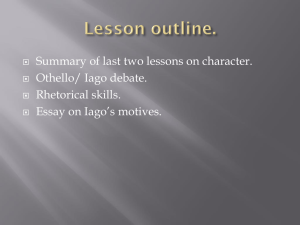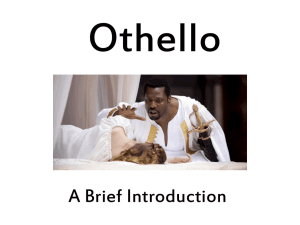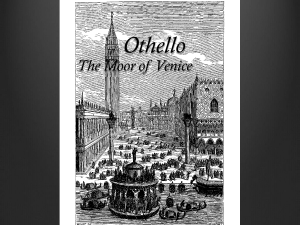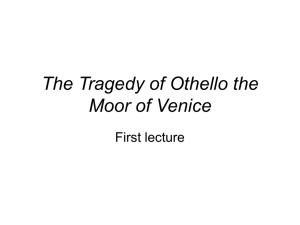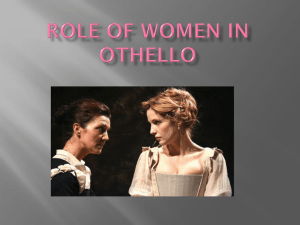othellobackgroundppt-110517115334
advertisement
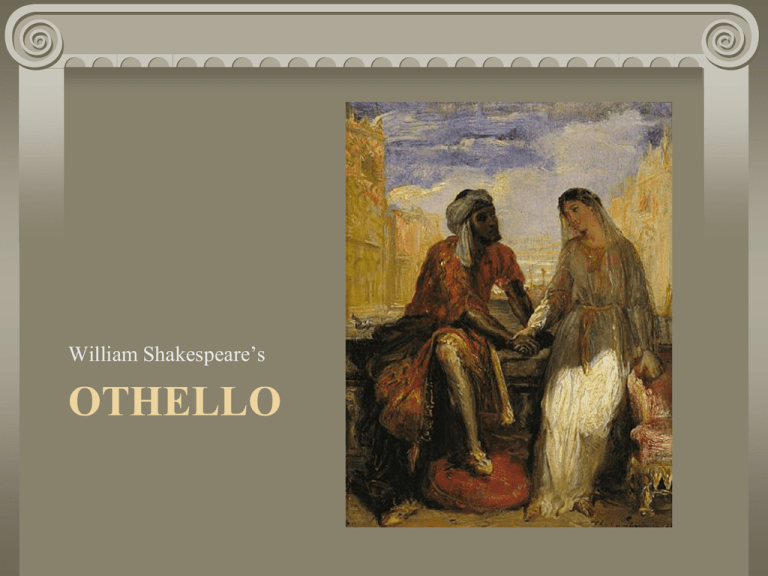
William Shakespeare’s OTHELLO Basic Info • Othello is unlike other Shakespearean tragedies • No secondary plot like his other tragedies • Villain (Iago) is responsible for the downfall of the tragic hero (Othello) • Ideas for this play taken from a collection of tales called Gli Hecatommithi by Giraldi Cinthio, published in Venice in 1565 Writing of the Play Othello: This play was probably written in 1601 (for Elizabeth), a little past the middle of Shakespeare's career (he was 40). Performed at the royal court Christmas season of 1604 when command performances of entertainments for the king and courtiers were customary. That means it had probably already been a success. Performance First recorded performance took place in 1604 for King James I; Richard Burbage, Shakespeare’s partner and fellow actor, played Othello Main Characters Othello: Soldier from North Africa; Employed as a general by the city-state of Venice; Highly respected, but still an “outsider” because of his skin colour; Marries Desdemona Main Characters, cont. Desdemona Beautiful and accomplished young Venetian woman; Protected by her father; She stands for love, trust, and purity—all that makes life meaningful and worth living Main Characters, cont. Iago (James in Spanish) Soldier who works with Othello; Wants to be Othello’s second in command but is passed over for Cassio; Seeks vicious revenge; Plots to destroy all that Othello values Emilia Maidservant to Desdemona; married to Iago; loyal to Desdemona, but will tell lies if it will help her husband Main Characters, cont. Cassio Gentleman soldier, Not much real experience Man of ability, loyalty and grace; Respects Desdemona and Othello; Is NOT a love interest for Desdemona; Suffers from a drinking problem Brabantio Father of Desdemona; Venetian nobleman and senator Roderigo In love with Desdemona; Listens to Iago’s plan to get Desdemona away from Othello; A fool! Static & Dynamic Characters Dynamic Character– Character changes from beginning to end Static Character – Character does not change Static & Dynamic Characters Othello is a strong example of a DYNAMIC CHARACTER Courageous Venetian soldier Well respected Has reputation as man of honour Has vicious temper Becomes enraged with jealousy Static & Dynamic Characters Iago is a STATIC CHARACTER Corrupt character Hypocritical Evil Selfish Focused throughout the play to destroy Othello Foil FOIL—character who highlights or emphasizes certain traits of the main character by contrasting them EX: Emilia is the foil to Desdemona EX: Cassio is the foil to Iago Conflicts, Internal Othello vs. Himself Doesn’t want to distrust Desdemona Insecure about his qualities to enable Desdemona to love him Conflicts, External Iago vs. Othello Iago hates Othello and plots to bring about his downfall Iago vs. Cassio Iago is jealous of Cassio, and works to ruin his reputation, as well as separate him from Othello’s friendship Irony – 3 Types Dramatic Irony: a contradiction between what a character thinks and what the reader or audience knows to be true Situational Irony: an event occurs that directly contradicts the expectations of the characters, readers, or audience Verbal Irony: words are used to suggest the opposite of what is meant (i.e. sarcasm, double-entendre, etc.) Themes Destructive nature of Jealousy Iago jealous of Cassio’s position Othello suspecting Desdemona’s unfaithfulness Importance of Honour and Reputation Cassio Desdemona Being an outsider Prejudice against Othello Skin color – Black & White Imagery From Africa, not Venice Warrior rather than courtier and politician Unfamiliar with societal conventions Dealt mainly with men and battle, not women and love Themes Appearance Versus Reality “Honest Iago” Desdemona & Cassio Loyalty Versus Treachery The ones Othello believes are treacherous are actually loyal Cassio Desdemona Role of Emilia With her husband With Desdemona Themes, cont. ENVY BETRAYAL CORRUPTION OF MORAL ORDER (Coveting thy neighbour’s wife) HONESTY Here are some TRUST themes to look for BLIND AMBITION INNOCENCE DESTROYED Can you find others? PASSION (AS A DESTRUCTIVE FORCE) Motifs MOTIFS—Major topics related to theme Animals Jealousy Sight and darkness The handkerchief Magic Evil and the devil Setting Act I Venice Act II –V Cyprus 16th Century Entire play spans over a couple of days Locations - Venice Symbol for REASON, ORDER, LAW (Senate) Known as the “pleasure capital”, immoral A city-state of enormous mercantile wealth, (wealth from trade; major sea port) Venice in Shakespeare's time was a byword for luxury and culture and was also famous for its Judicial system Its trade was partially choked off by the growing power of the Turkish empire in the 16th century, which extended into Europe as well as Asia and Arabia. Hence the importance of Cyprus. Locations - Cyprus Rough island, near Turkey and Syria, Known as greatest source of Venetian wealth and power in the Eastern Mediterranean so needed protection was annexed by Venice in 1489 and conquered by the Turks in 1571. Geography, significance of Venice is a symbol for order and Turkey is a symbol for barbarianism so Cyprus is inbetween It’s an island amidst a raging sea, close to enemy Less reason here Only Othello can keep order, but he himself comes from “savage” origins Terms & Concepts MOOR. In Shakespeare's time, equivalent to "African," with the expectation that ,such a person would be black. This was not a negative or derogatory word. Originally, it meant "native of Mauretania," a country in North Africa (present day Morocco, of the Berber and Arab race), but its meaning had become generalized by the 17th century. OTTOMAN, OTTOMITES. These terms (I.3.49, 11.3.170) refer to the Turks (Turkey; also known as INFEDELS (unbelievers, nonChristians). Brief History of the Moors In 711 Moors, who are Muslim, conquered Spain and ruled until 1492—Queen Isabella and King Ferdinand took over and brought Christianity to Spain Moors forced to leave Spain or become Christian (convert); many left the country and became Gypsies in Europe and pirates in the seas near Europe, Asia & Africa Xarife, the Moor Moors were often associated with slavery and “otherness” (foreigner) because of their non-white skin Stereotypes of Moors: uncivilized, highly sexual, prone to anger In 1600, a Moorish ambassador arrived in England named Xarife to discuss an alliance with the Turks Unlike other common Moors, he was welcomed by Queen Elizabeth and treated like black royalty Critics attribute Othello’s high ranking/ character to this event during that time Elizabethan Attitudes Play first performed in 1604, when Christian European tolerance of Muslims was greatly strained Shakespeare created the character of Othello as a tragic hero, not a villain Othello’s Position & Status Professional soldier who, after much battlefield experience, is currently employed by Venice as general of its forces. He is called "General" or, sometimes, "Captain." He holds a high position and is greatly respected. Military Terms ANCIENT Pronounced “en-sin” A military rank, properly of a standardbearer (same word as "ensign"). This is Iago's rank, which he resents. He is third in command to Othello, behind Cassio. Military Terms LIEUTENANT. The rank which Cassio has just been given, literally meaning "place-holder." Second in command to Othello, he holds Othello's place in his absence. Ironically, Othello comes to believe that Cassio holds Othello's place in Desdemona's affections. Even more ironically, the play ends with Cassio literally put into Othello's place as governor of Cyprus. Othello Background SHAKESPEAREAN TRAGEDY Tragedy Drama in which the main character suffers a disaster after a serious struggle Faces downfall in a heroic way Tragic Hero 1. Noble/influential person who 2. Meets with destruction because: personal flaw (fatal flaw) Opposition of others Othello fits this description 3. Harsh punishment (arouses pity in audience) 4. Character gains self-knowledge 5. Catharsis resulting in compassion Catharsis = cleansing or release of tense emotions Fatal Flaw Error, weakness, mistaken judgment or misstep that causes the downfall of the hero Also called hamartia from Greek Hero is not perfect & may make errors from Ambition Ignorance Pride Jealousy Gullibility (believes others too easily) Diagram: Tragic Hero Power, Wealth Self Knowledge Beginning of story End of story Self Knowledge Disaster/Death/ Loss of Power Elizabethan Tragic Heroes The Elizabethan tragic hero is much more often responsible for his own downfall rather than being a victim of fate (FLAW) Emphasizes the “waste of human potential” Othello is the tragic hero The Five-Part Dramatic Structure Act III Crisis, or Turning Point Act II Rising Action, Or Complications Act I Exposition, or Introduction Act IV Falling Action Act V Resolution, or Denouement Soliloquy Character’s inner thoughts (truthful) spoken aloud No other characters present Aside Character’s inner thoughts spoken aloud Other characters are present Other characters cannot hear the spoken thoughts (even though the actors can) Elizabethan Theater Little to no props used Minimal scenery Rarely performed at night Lighting Female Parts played by teenaged boys Against the law for women to act Actors not respected One step above beggars Globe Theater Open air Galleries Audience area covered by a roof (3 levels) Yard Audience area w/o covering or seating “Groundlings” hazelnuts Globe Theater, cont. Pricing based on comfort 1 penny (week’s wages for apprentice) 5 pence – cushioned gallery seat Nobility generally had private performances at their homes Stage Views Platform Stage Raised stage that projects into the audience Stage Heavens Pictures of moon, stars, & zodiac painted on the underside of the canopy covering the stage Hell Under the stage Used for prop storage Trap door entrance to main stage Tiring House Three-level inner stage area (background) Inner stage: (study) 1st floor Balcony stage 2nd floor Music Gallery 3rd floor Also used as a stage Tiring House, Cont. Chamber Curtained area behind balcony Bay window stages Stages on the sides of the balcony stages Shakespeare’s Language Iambic Pentameter Most common rhythm in English poetry Iamb: 2-syllable foot Foot: unit of rhythm in poetry and drama Unstressed, stressed I.e. today = to DAY Pentameter: five foot line Blank verse: unrhymed Iambic Pentameter Ways to Understand More Easily Word Order Literary Devices Read in sentences Don’t break at ends of lines Archaic Language Written in 1599 Footnotes Overall sense Don’t worry about every single word Contractions Glossary/ Key terms




